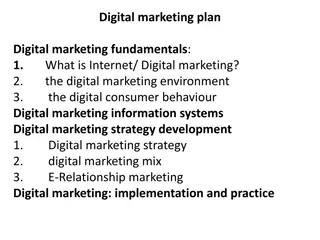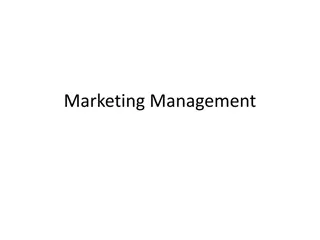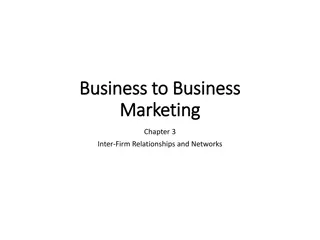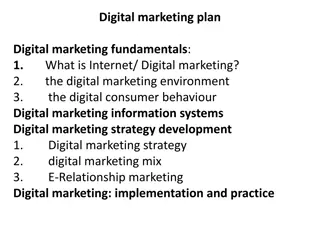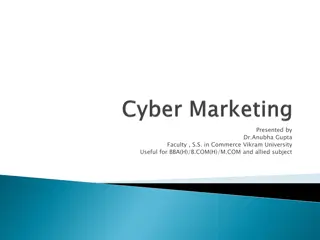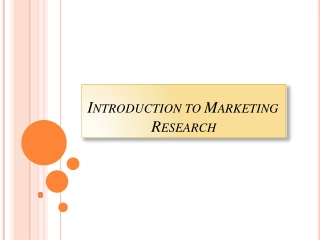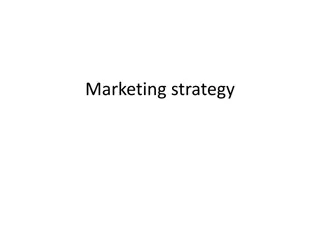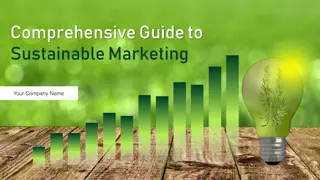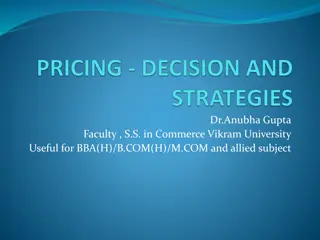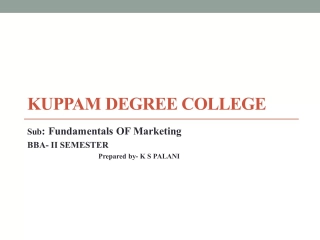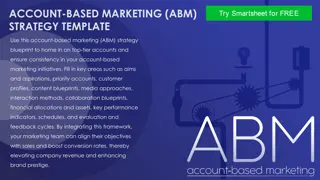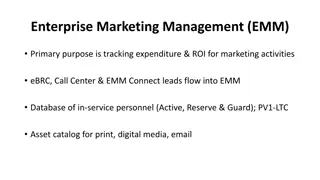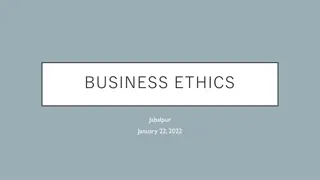Understanding the Impact of Marketing Environment on Business Decisions
The marketing environment comprises various external factors affecting a company's ability to serve customers, including demographic, economic, natural, technological, political, and cultural aspects. Changes in these environments influence marketing decisions, and companies must adapt to seize opportunities and address threats. By analyzing the micro and macro environmental components, firms can make informed strategic choices in alignment with their mission and objectives. Collaboration across departments and a customer-centric approach are crucial for success in a dynamic marketplace.
Download Presentation
Please find below an Image/Link to download the presentation.
The content on the website is provided AS IS for your information and personal use only. It may not be sold, licensed, or shared on other websites without obtaining consent from the author. Download presentation by click this link. If you encounter any issues during the download, it is possible that the publisher has removed the file from their server.
Presentation Transcript
THE MARKETING ENVIRONMENT
With this we learn. The environmental forces that affect the company s ability to serve its customers. Explain how changes in the demographic and economic environments affect marketing decisions. Identify the major trends in the firm s natural and technological environments. Explain the political and cultural environments. Discuss how companies can react to the marketing environment.
To identify opportunities and monitor threats, the company must have a thorough understanding of the marketing environment in which the firm operates The marketing environment consists of all the factors and forces outside marketing that affect the marketing management s ability to develop and maintain successful relationships with its target customers These factors and forces may vary depending on the specific company and industrial group, and are generally divided into micro environmental and macro environmental components The micro environmental components are, the company, suppliers, marketing (intermediaries), customer markets, competitors, and publics channel firms
The opportunities and threats. Changes in the marketing environment often occur at a rapid pace. Marketers tend to be trend trackers and opportunity seekers. The company must use its marketing research and marketing intelligence systems to monitor the changing environment. A systematic scan of the environment helps marketers to revise and adapt marketing strategies to meet new challenges and opportunities in the marketplace. marketing environment offers both
The companys microenvironment The Company The first actor is the company itself and the role it plays in the microenvironment. Top management is responsible for setting the company s mission, objectives, broad strategies, and policies. Marketing managers must make decisions within the parameters established by top management. Marketing managers must also work closely with other company departments Areas such as finance, R & D, purchasing, manufacturing, and accounting produce better results when aligned by common objectives and goals.
All departments must think consumer if the firm is to be successful. Suppliers Suppliers are firms and individuals that provide the resources needed by the company and its competitors to produce goods and services and are an important link in the company s overall customer value delivery system. They watch supply availability (such as supply shortages) They monitor the price trends of key inputs.
Marketing Intermediaries These are firms that help the company to promote, sell, and distribute its goods to final buyers. Resellers are distribution channel firms that help the company find customers or make sales to them. These include wholesalers and retailers who buy and resell merchandise. Resellers often perform important functions more cheaply than the company can perform itself Physical distribution firms help the company to stock and move goods from their points of origin to their destinations. Example warehouses (that store and protect goods before they move to the next destination)
Marketing services agencies (such as marketing research firms, advertising agencies, media firms, etc.) help the company target and promote its products to the right markets. Financial intermediaries(such as banks, credit companies, insurance companies, help finance transactions and insure against risks associated with buying and selling goods.
Customers The company must study its customer markets closely because each market has its own special characteristics and these markets normally include: Consumer markets (individuals and households that buy goods and services for personal consumption). Business markets (buy goods and services for further processing or for use in their production process). Reseller markets (buy goods and services in order to resell them at a profit).
Competitors Every company faces a wide range of competitors and it must secure a strategic advantage over competitors to be successful in the marketplace. No single competitive strategy is best for all Publics A publicis any group that has an actual or potential interest in or impact on an organization s ability to achieve its objectives. A company should prepare a marketing plan for all of its major publics as well as its customer markets
Publics can be identified as being: Financial publics, Media publics, Government publics, Citizen-action publics, Local publics, General public and Internal publics
The companys macro environment Demographic Environment Demography is the study of human populations in terms of size, density, location, age, gender, race, occupation, and other statistics and is of major interest to marketers because it involves people, and people make up markets. Demographic trends are constantly changing and interesting trends such as the world population, the age structure of many nations where there is a slowdown of birthrate and the life expectancy is increasing, the geographic shifts has made the marketers to think and act accordingly
Economic Environment The economic environment includes those factors that affect consumer buying power and spending patterns. Major economic trends include Changes in income consumers are more careful shoppers. Value marketing (trying to offer the consumer greater value for their dollar) a very serious strategy in the 2000s. Real income is on the rise again but is being carefully guarded by a value-conscious consumer.
Income distribution is still very skewed in the United States and all classes have not shared in prosperity it is also of note that distribution of income has created a two-tiered market where there are those that are affluent and less affluent. Classes of consumers include: Upper class spending patterns are not affected by current economic events and who are a major market for luxury goods. Middle class somewhat careful about its spending but can still afford the good life of some time
Working classwho stick close to the basics of food, clothing, and shelter and try hard to save. Under class (persons on welfare and many retirees) must count their pennies when making even the most basic purchases. Also the Changing consumer spending patterns affect consumer buying behavior
Natural Environment The natural environment involves natural resources that are needed as inputs by marketers or that are affected by marketing activities. During the past two decades environmental concerns have steadily grown Technological Environment The technological environment includes forces that create new technologies, creating new product and market opportunities. It is perhaps the most dramatic force shaping our destiny New technologies create new markets and opportunities and every new technology, replaces an older technology.
Political Environment The political environment includes laws, government agencies, and pressure groups that influence and limit various organizations and individuals in a given society. Cultural Environment The cultural environment is made up of institutions and other forces that affect society s basic values, perceptions, and behaviors and many cultural characteristics can affect marketing decision-making
Responding to the Marketing Environment Many companies view the marketing environment as an uncontrollable element to which they must adapt Today, many companies are taking an environmental management perspective whereby a firm takes aggressive (rather than passive) actions to affect the publics and forces in the marketing environment. . Whenever possible smart managers will take a proactive rather than a reactive approach to the marketing environment.
Recent technological advances, including the widespread use of the Internet, have initiated what some call the new digital age. This chapter visits this new digital age and all of its ramifications To be successful in this new digital age, new applications and paradigms must be tried and Because the world economy is shaped by technology, globalization, environmentalism, these applications and paradigms must be formulated with consideration of the major forces that are shaping this new digital age.
Conducting business in the new digital age will call for a new model for marketing strategy and practice. In essence, a new industrial revolution is underway. Some strategists even envision a day when all buying and selling will involve direct electronic connections between companies and their customers. The new model will fundamentally change customers notions of convenience, speed, price, product information, and service and new benefits to buyers and sellers will emerge and even small e-marketers will have ready access to global markets.
To discuss how the new digital age has developed, the chapter focuses on four major Internet domains B2C (business to customer), B2B (business to business), C2C (consumers to consumers), and C2B (consumers to businesses)
The major forces shaping the modern marketing Digitalization and Connectivity Today a growing number of appliances and systems operate on digital information Much of the world s business today is carried out over networks that connect people and companies. Through Intranets which are networks that connect people within a company to each other and to the company network. Through Extranets which connect a company with its suppliers, distributors, and other outside suppliers. The Internet is a vast public web of computer networks that connects users of all types all around the world to each other and to an amazingly large
The Internet Explosion With the creation of the World Wide Web and Web browsers in the 1990s, the Internet was transformed from a mere communication tool into a certifiably revolutionary technology. This explosive worldwide growth in Internet usage forms the heart of the New Economy.
New Types of Intermediaries New companies called dot.coms have been created with hopes of striking gold in the New Economy marketplace. With the success of the new companies, store-based retailers began to doubt their strategies and futures. They feared, by being disintermediated by the new e- tailers being cut out by this new type of intermediary. The formation of new types of intermediaries and new forms of channel relationships caused existing firms to re-examine how they served their markets.
Customization and Customerization The Old Economy revolved around manufacturing companies. The New Economy revolves around information businesses. Information has the advantages of being easy to differentiate, customize, personalize, and dispatch at incredible speeds over networks. Customization differs from customerization. Customization involves taking the initiative to customize the market offering. Customerization occurs when the company leaves it to the individual customers to design the offering. Companies following this design have become facilitators and their customers have moved from being customers to being prosumers.
Marketing Strategy in the New Internet Age Conducting business in the New Economy will call for a new model for marketing strategy and practice. The new model will fundamentally change customers notions of convenience, speed, price, product information, and service. Today s economy requires a mixture of Old Economy and New Economy thinking and action. Marketing should play alead role in shaping new company strategy. e-Business, e-Commerce, and e-Marketing in the New Digital Age One of the mainstays of the New Economy is e-business which involves the use of electronic platforms intranets, extranets, and the Internet to conduct a company s business.
Many companies such as Cisco, Microsoft,
Benefits to Buyers Internet buying benefits final buyers and business buyers in many ways: It is convenient, is easy and private Through the Internet, often buyers are provided with greater product access and selection. Buyers have access to a wealth of comparative information. Online buying is interactive and immediate.
Benefits to Sellers The Internet is a powerful tool for customer relationship building. Reducing costs and increasing speed and efficiency are also advantages of using the Internet and electronic channels. E-marketing offers greater flexibility, allowing the marketer to make ongoing adjustments to its offers and programs. The Internet is truly a global medium that allows buyers and sellers to click from one country to another in seconds.
E-Commerce Domains The four major Internet domains include B2C (business to consumer), B2B (business to business), C2C (consumers to consumers), and C2B (consumers to businesses). B2C (Business to Consumer) B2C (business-to-consumer) e-commerce is the online selling of goods and services of goods and services to final consumers. Consumer buying online growing at a healthy rate and the largest categories are travel services, clothing, computer hardware and software The cybercustomer is no longer a pasty-faced nerd. Instead, the cyberspace customer is becoming more mainstream and diverse and almost all groups are
B2B (Business to Business) Consumer goods sales via the Web dwarfed by B2B (business-to-business) e-commerce. This include trading networks, auction sites, spot exchanges, online product catalogs, and barter sites Most major business-to-business marketers now offer product information, customer purchasing, and customer support services online. Much B2B e-commerce takes place in open trading networks huge e-marketspaces in which buyers and sellers find each other online, share information, and complete transactions efficiently.
Online sellers are setting up their own private trading networks (PTNs). Private trading networks link a particular seller with its own trading partners. These networks give the seller greater control over product presentation and allow for deeper relationships. C2C (Consumer to Consumer) C2C (consumer-to-consumer) e-commerce and communication occurs on the Web between interested parties over a wide range on products and subjects.
C2C involves interchanges of information through forums and Internet newsgroups that appeal to specific special-interest groups. Forums are discussion groups located on commercial online services. Newsgroups are the Internet version of forums. C2C means that online visitors don t just consume product information increasingly, they create it.
C2B (Consumer to Business) C2B (consumer-to-business) e-commerce occurs when consumers contact and communicate with companies. Consumers are searching for and receiving information about companies and use the Web to drive transactions with businesses.
Setting Up an e-Marketing Presence All companies need to consider moving into e-marketing. Methods for doing so include: 1). Creating a Web site. Corporate Web site the most basic type. And are designed to build customer goodwill and to supplement other sales channels, rather than to sell the company s products directly. They generally provide information
Marketing Web sitethese sites engage consumers in an interaction that will move them closer to a direct purchase or other marketing outcome. Companies often aggressively promote these sites in other media forms such as magazines and is used effectively by B2B marketers. 2). Placing ads online. 3). Setting up or participating in Web communities. 4). Using online e-mail or Webcasting.
Concerns to be addressed are Internet profitability Limited exposure and buying Skewed demographics. Online users tend to be more upscale and more technology oriented than the general population. In most product categories, users still do more window browsing and product research than actual buying. Chaos and clutter. The Internet, with its millions of options, can be a very confusing and cluttered place. Online privacy and security. Ethical concerns








